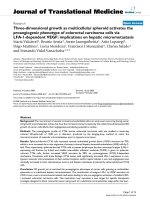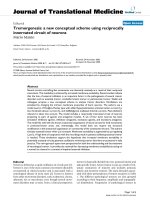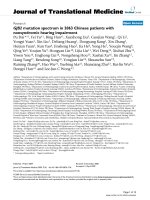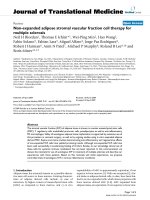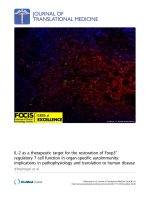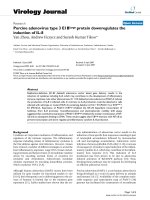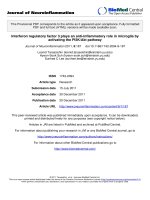Báo cáo hóa học: " Porcine adenovirus type 3 E1Blarge protein downregulates the induction of IL-8" ppt
Bạn đang xem bản rút gọn của tài liệu. Xem và tải ngay bản đầy đủ của tài liệu tại đây (541.42 KB, 8 trang )
BioMed Central
Page 1 of 8
(page number not for citation purposes)
Virology Journal
Open Access
Research
Porcine adenovirus type 3 E1B
large
protein downregulates the
induction of IL-8
Yan Zhou, Andrew Ficzycz and Suresh Kumar Tikoo*
Address: Vaccine and Infectious Disease Organization, University of Saskatchewan, Saskatoon, Saskatchewan, Canada
Email: Yan Zhou - ; Andrew Ficzycz - ; Suresh Kumar Tikoo* -
* Corresponding author
Abstract
Replication-defective (E1-E3 deleted) adenovirus vector based gene delivery results in the
induction of cytokines including IL-8, which may contribute to the development of inflammatory
immune responses. Like other adenoviruses, E1 + E3 deleted porcine adenovirus (PAdV) 3 induces
the production of IL-8 in infected cells. In contrast, no IL-8 production could be detected in cells
infected with wild-type or mutant PAdV-3s containing deletion in E1A + E3 (PAV211) or E1B
small
+
E3 (PAV212). Expression of PAdV-3 E1B
large
inhibited the NF-κB dependent transcription of
luciferase from IL-8 promoter. Imunofluorescence and electrophoretic mobility shift assays
suggested that constitutive expression of PAdV-3 E1B
large
inhibited the nuclear translocation of NF-
κB and its subsequent binding to DNA. These results suggest that E1B
large
interacts with NF-κB to
prevent transcription and down regulate proinflammatory cytokine IL-8 production.
Background
Cytokines are important mediators of inflammation and
regulators of the immune response. The inflammatory
response including release of inflammatory cytokines is
the first defense against viral infection. However, viruses
have evolved a number of different strategies to avoid the
host inflammatory responses. Large DNA viruses includ-
ing poxviruses and herpes viruses [1-6] modulate cytokine
action by encoding secreted forms of receptors for
cytokines and chemokines. Adenoviruses modulate
cytokine expression by encoding intracellular proteins,
which counteract TNF-α [7,8].
Although human adenovirus (HAdV) vectors have been
utilized for gene transfer for functional studies in vivo
[9,10], their therapeutic use in delivering genes to the air-
ways of humans is limited due to the transient gene
expression [11]. Earlier studies have shown that the air-
way administration of adenovirus vector results in the
induction of non specific host responses consisting in part
of neutrophil accumulation followed by mononuclear
cell and macrophage accumulation. Adenovirus vector
infection of airway epithelial A549 cells [12,13] or airways
of macaques [14] results in rapid induction of the inflam-
matory cytokine IL-8, which may contribute to the inflam-
matory host response [12]. This induction of IL-8
production has been shown to be due to adenovirus
induced activation of Raf/MAPK pathway [15]. Thus,
blocking these pathways may be required for developing
an efficient adenovirus vector.
Porcine adenovirus (PAdV) 3, a non human adenovirus is
being developed as a vector for gene delivery in animals
and humans [16,17]. Availability of the complete nucle-
otide sequence and transcription map of PAdV-3 [18]
genome has facilitated the construction of recombinant
Published: 12 June 2007
Virology Journal 2007, 4:60 doi:10.1186/1743-422X-4-60
Received: 5 April 2007
Accepted: 12 June 2007
This article is available from: />© 2007 Zhou et al; licensee BioMed Central Ltd.
This is an Open Access article distributed under the terms of the Creative Commons Attribution License ( />),
which permits unrestricted use, distribution, and reproduction in any medium, provided the original work is properly cited.
Virology Journal 2007, 4:60 />Page 2 of 8
(page number not for citation purposes)
PAdV-3s [16,17,19,20] and their use as vaccine delivery
vehicles [21]. Earlier, analysis of early region 1 (E1) of
PAdV-3 suggested that while E1A [20] and E1B
large
[19] are
essential for virus replication, E1B
small
is not essential for
virus replication [20]. Here, we report that E1B
large
can
impair the induction of inflammatory cytokine IL-8 by
inhibiting the NF-κB dependent gene transcription.
Results and discussion
RNase protection assay
Earlier, induction of chemokines has been reported in
adenovirus vector infected mouse renal epithelial cells
[22], A549 cells [12] and HeLa cells [15], but not in U373
cells [7]. Moreover, both E1A and E3 gene products have
been shown to down regulate the transcription of some
chemokines [7,23]. To determine the effect of PAdV-3 E1
proteins on the induction of chemokines, HeLa cells were
infected with PAV211 (E1A nt [530–1230] + E3 [nt
28112–28709] deleted), PAV212 (E1B
small
[nt 1460–
1820] + E3 [nt 28112–28709] deleted), PAV227 (E1A +
E1B
small
+ E1B
large
[nt 524–3274] + E3 [nt 28112–28709]
deleted) or PAV300 (E3 [nt 28112–28709] deleted) at an
MOI of 100 infectious units [24]. The construction and
characterization of the mutant PAdV-3s has been
described [19,20]. At 6 h post infection, the cells were har-
vested and processed for the isolation of total RNA using
TRIZOL (Invitrogen) as per manufacturer's protocol.
RNase protection assay was performed with the Ribo-
Quant Muti-Probe template (BD Biosciences) set hCK-5
as per manufacturer's protocol. Autoradiographs were
analyzed by a Molecular phosphoimager FX and Quantity
One software (BIO-RAD). As seen in Fig. 1A, no chemok-
ine specific transcript could be detected in the cells
infected with wild-type or mutant PAdV-3 containing
deletion of E3 (PAV300), E1A + E3 (PAV211) or E1B
small
+ E3 (PAV212). Interestingly, IL-8 transcript was the dom-
inant chemokine gene induced in the cells infected with
recombinant PAdV-3 containing deletion of E1A +
E1B
small
+ E1B
large
+ E3 (PAV227). These results suggest
that E1B
large
protein inhibit the expression of inflamma-
tory cytokine IL-8.
Luciferase reporter assay
Since increased expression of proinflammatory chemok-
ines including IL-8, in response to various stimuli includ-
ing adenovirus vectors can be upregulated by NF-κB
transcription factor [22], we employed luciferase reporter
assay to examine the inhibition of transcriptional activa-
tion of IL-8 promoter (containing consensus sequence for
NF-κB binding) by E1B
large
protein. As seen in Fig. 1B,
reduced levels of the luciferase activity were obtained
when phIL8-Luc DNA was cotransfected with pCDNA3.1-
pE1BL DNA (expressing E1B
large
). In contrast, significant
levels of luciferase activity were detected when phIL8-Luc
DNA was cotransfected with pCDNA3.1 DNA showing
that the competition for transcription factors binding to
E1B
large
expression vector did not nonspecifically reduce
the activity of luciferase reporter gene. The results of the
reporter gene expression indicated that E1B
large
reduced
the NF-κB activated gene expression and was responsible
for the observed inhibition of inflammatory cytokine IL-8
production.
E1B
large
inhibits the translocation of NF-
κ
B to the nucleus
NF-κB is a dimmer of two heterologous proteins (p65 and
p50) held in an inactive complex by an endogenous
inhibitor IκB, in the cytoplasm [25]. After cell activation,
IκB is phosphorylated and subsequently degraded releas-
ing NF-κB, which translocates to the nucleus where it
binds to the enhancer elements upstream from the tran-
scriptional initiation site of proinflammatory cytokine
genes [25]. In order to determine if the expression of
E1B
large
alters the translocation of NF-κB to the nucleus,
we analyzed the localization of p65 protein in VIDO R1
(fetal porcine retina cells expressing HAdV-5 E1A +
E1B
small
)[17] or VR1BL (fetal porcine retina cells express-
ing HAdV-5 E1A + E1B
small
and PAdV-3 E1B
large
)[19] cells
using immunofluorescene assay. As seen in Fig. 2A, NF-κB
is predominantly located in the cytoplasm of VIDO R1
cells [17]. As expected, TNF-α treatment translocated NF-
κB to the nucleus of VIDO R1 cells. Similarly, NF-κB is
predominantly located in the cytoplasm of VR1BL [19]
cells (Fig 2B). However, TNF-α treatment did not alter the
cytoplasmic location of NF-κB in VR1BL cells. These
results suggest that the constitutive expression of PAdV-3
E1B
large
is able to inhibit the translocation of NF-κB in
TNF-α treated VR1BL cells.
E1B
large
affects the NF-
κ
B binding to oligonucleotides
containing NF-
κ
B consensus sequence
In order to investigate the effect of PAdV-3 E1B
large
protein
on binding of NF-κB protein to an oligonucleotide con-
taining the IL-8 NF-κB DNA sequence [26,27], initially,
we analyzed the nuclear extracts from transfected and
nontransfected cells by electrophoretic mobility shift
assay (EMSA). HeLa cells were transfected either with plas-
mid pCDNA3.1 DNA or with plasmid pcDNA3.1-pE1BL
DNA as described above. At 48 h post transfection, the
cells were left untreated or treated with TNF-α for 30 min
before HeLa cell nuclear lysates were prepared as
described previously [28]. The nuclear extracts were ana-
lysed by EMSA using labeled oligonucleotides containing
wild-type NF-κB or mutant NF-κB. The results are shown
in Fig. 3. As expected TNF-α treatment induced the bind-
ing of NF-κB to its consensus binding sequence in nuclear
lysates of the cells transfected with plasmid pCDNA3.1
(panel A I). No such binding was observed following TNF-
α treatment of the cells transfected with pCDNA3.1-
pE1BL. Super shift assays using anti-NF-κB p65 antibodies
demonstrated a supershifted band in the nuclear extracts
Virology Journal 2007, 4:60 />Page 3 of 8
(page number not for citation purposes)
of cells transfected with pCDNA3.1 DNA (panel A II). No
such band could be observed when mutant NF-κB oligo-
nucleotides were used as a probe with the nuclear extracts
of the cells transfected with pCNDA3. or pCDNA3.1-
pE1BL DNAs (panel A III). To further confirm these
results, swine testicular (ST) cells were infected with wild-
type or mutant PAdV-3s. At 6 h post infection, the infected
cells were collected and the nuclear cell extracts prepared
as described above. The nuclear extracts were analyzed by
EMSA using wild-type or mutant NF-κB probe. As
expected, NF-κB binding to oligonucleotides containing
NF-κB consensus sequence could be detected in the
nuclear extracts of the cells infected with PAV227 (Panel
BI). No such binding could be detected when mutant NF-
κB sequence was used with the nuclear extracts in EMSA
(Panel BII). These results confirmed that E1B
large
(panel C)
mediated the inhibition of NF-κB translocation to the
nucleus of the cell, hence preventing the NF-κB binding to
NF-κB consensus sequences in the nucleus.
Conclusion
In summary, we have demonstrated that PAdV-3 E1B
large
protein downregulates the induction of proinflammatory
cytokine IL-8 by inhibiting the NF-κB dependent gene
transcription from human IL-8 promoter. Moreover,
immunofluorescence and EMSA data suggest that the
E1B
large
protein inhibits the nuclear translocation of NF-
κB by interacting with NF-κB. One possible mechanism of
E1B
large
action could be to act as IκB homolog and retain
the ability to bind, and inactivate NF-κB. Interestingly,
PAdV-3 E1B
large
shows 20% identical and 38% homology
(Fig. 4) at the amino acid level to porcine IκB protein
PAdV-3 E1B
large
inhibit IL-8 productionFigure 1
PAdV-3 E1B
large
inhibit IL-8 production. (A) Total RNA isolated at 6 h post infection of HeLa cells with indicated viruses
was analyzed by RNA protection assay using RiboQuant Multi-Probe template set hCK-5. The protected band indicated by the
label on the right migrate faster that undigested probes, as expected.(B).HeLa cells transfected with the human IL-8 promoter
containing a NF-κB recognition sequence, cloned upstream from a luciferase reporter cDNA in the presence of plasmid
pCDNA3.1 or pCDNA3.1-pE1BL were assayed for luciferase activity (expressed as relative light units [RLU]). The error bars
represent the standard error of mean of triplicate samples.
Ltn
RANTES
IP-10
MIP-1β
MIP-1α
MCP-1
IL-8
I-309
L32
GAPDH
mock
PAV211
PAV212
PAV227
PAV300
PAV wt
(A)
hCK-5
0
20
40
60
80
100
120
pIL8-Luc+pcDNA3.1 pIL8-Luc+pcDNA3.1-pE1BL
RLU
(B)
Virology Journal 2007, 4:60 />Page 4 of 8
(page number not for citation purposes)
(GenBank Accession # A38490). Similar homology is
reported between African swine fever virus encoded IκB
(A238L) protein and porcine IκB protein [29]. Alterna-
tively, the nuclear localization of E1B
large
[19] could have
direct inhibitory effect on IL-8 transcription. These results
suggest that the construction of adenovirus vectors to
include E1B
large
expression cassettes will improve the effi-
cacy and safety of such vectors.
Methods
Viruses and cells
Recombinant PAdV-3 bearing deletions in the E1 region
were generated as described previously [20]. PAV211 con-
tains deletions in the E1A + E3 regions, PAV212 contains
deletions in the E1B
small
+ E3 regions, PAV227 contains
deletions in E1 + E3 regions and PAV300 contains dele-
tion in E3 region. Viruses were propagated and titrated as
described [19,20,24]. HeLa cells were maintained in Dul-
becco's modified Eagle's medium (DMEM) containing
10% fetal calf serum (FCS).
RNase protection assays. Monolayers of HeLa cells (1X10
5
/
well) in 12 well plate were infected with wild-type or
mutant PAdV-3s at a MOI of 100. At 6 h post infection,
HeLa cells were harvested and processed for total RNA
using TRIZOL (Invitrogen) as per manufacturer's proto-
col. RNase protection assay was performed with the Ribo-
Quant Multi-Probe template (BD Biosciences) set hCK-5
as per manufacturer's protocol. Autoradiographs were
analyzed by phosphoimaging with a Personal FX phos-
phoimager and Quantity One software (Bio-Rad).
Expression of NF-κBFigure 2
Expression of NF-κB. The cells constitutively expressing (VR1BL) or not expressing (VIDO R1) PAdV-3 E1B
large
were
treated with TNF-α. After 15 min, the cells were fixed with 100% methanol and analyzed by indirect immunostaining with anti-
NF-κB p65 antibody followed by Cy™ conjugated goat anti-mouse secondary antibody. Finally, the cells were incubated with
DAPI and visualized using Zeiss AxioVision microscope. (A) VIDO R1 cells, (B) VR1BL cells. DAPI (blue); NF-κB p65 (red).
-TNFα
+TNFα
-TNFα
+TNFα
(A)
(B)
Virology Journal 2007, 4:60 />Page 5 of 8
(page number not for citation purposes)
Plasmid construction
The 181-bp human IL-8 promoter sequence (-135 to +46)
was PCR amplified from the genomic DNA [26,27]
derived from HeLa cells using the primers: hIL8 (-135)
Fw: 5'-CAATGCTAGCG AAGTGTGATGACTCAGG TT-3',
which contains a NheI restriction enzyme site (bold let-
ters), and hIL8 (+46) Bw: 5'-CGTTCTCGAGA AGCTTGT-
GTGCTCTGCTGT-3' containing a XhoI restriction enzyme
site (bold letters). The PCR product was digested with
NheI-XhoI and ligated to NheI-XhoI digested plasmid
pGL3-Basic (Promega) creating plasmid phIL8-Luc. The
plasmid phIL8-Luc contains luciferase gene under the
control of IL-8 promoter. Similarly, the coding region of
E1B
large
gene was PCR amplified using the primers: [PE1BL
(NheI) Fw: 5'-CAGTGCTAGCATGTTCCCTGC TGGAG-
GCGC-3', which contains a NheI restriction enzyme site
(bold letters), and PE1BL (XhoI) Bw: 5'-GTCA CTC-
GAGTC AGTCATC G TCATCGCTGAA-3' containing a
XhoI restriction enzyme site (bold letters)] and PAdV-3
genomic DNA as a template. The PCR product was
digested with NheI-XhoI and ligated to NheI-XhoI
digested plasmid pCDNA3.1(-) (Invitrogen) creating plas-
mid pCDNA3.1-pE1BL. The plasmid pCDNA3.1-pE1BL
contains E1B
large
gene under the control of human
cytomegalovirus immediate early (HCMV IE) promoter.
Luciferase assay
HeLa cells (1x10
5
cells/well) were plated in 12-well plate
and incubated overnight. Tansfections were carried out
using 0.5 μg of each plasmid [(phIL8-Luc, pCDNA3.1-
EMSA of nuclear extractsFigure 3
EMSA of nuclear extracts. (A). Nuclear extracts from the plasmid transfected cells (I, II, III) incubated with radiolabeled
oligonucleotide probe(s) containing wild-type (I, II) or mutant (III) NF-κB motif from human IL-8 promoter [30] with (II) or
without (I) immunoprecipitation with anti- NF-κB p65 serum. (B) Nuclear extracts from mock infected or virus infected cells
containing wild-type (I) or mutant (II) NF-κB motif from human IL-8 promoter. (C) Schematic diagram showing deletion of the
regions in PAV211, PAV212 and PAV227 [19,20].
V
e
c
t
o
r
V
e
c
t
o
r
E
1
B
L
E
1
B
L
TNF-α
αα
α
NF-κB
-+
-
+
V
e
c
t
o
r
V
e
c
t
o
r
E
1
B
L
E
1
B
L
TNF-α
αα
α
NF-κB
++++
-
+
-
+
Probe: NF-κB wt
V
e
c
t
o
r
V
e
c
t
o
r
E
1
B
L
E
1
B
L
TNF-α
αα
α
- +
- +
Probe: NF-κB mut
II III
I
M
o
c
k
P
A
d
V
W
T
P
A
V
2
1
1
P
A
V
2
1
2
P
A
V
2
2
7
M
o
c
k
P
A
d
V
W
T
P
A
V
2
1
1
P
A
V
2
1
2
P
A
V
2
2
7
Probe: NF-κBmutProbe: NF-κBwt
A
211
212
227
E1BL
(B)
(A)
(C)
Virology Journal 2007, 4:60 />Page 6 of 8
(page number not for citation purposes)
pE1BL] or [phIL8-Luc, pCDNA3.1])/well (in triplicate)
using 5 μl of lipofectin (Invitrogen), followed by incuba-
tion for 5 h in Opti-MEM (Invitrogen). After adding FCS
to each well to give a final concentration of 1%, the cells
were incubated for 18 h at 37°C. Finally, the cells were
washed with PBS and lysed in 200 μl of 1x lysis buffer
(Luciferase reporter assay kit, BD Bioscience). Luciferase
activity was determined using 50 μl of cell extract and was
read using a TD-20/20 luminomitor (Turner Designs).
Immunofluorescent Microscopy
VIDO R1 [17] and VR1BL [19] cells plated on glass cover-
slips were untreated or treated with 10 ng/ml TNF-α (R&D
System). At 15 min post treatment, the cells were washed
with PBS, fixed and permeabilized by incubating with
methanol/acetone (1:1) at -20°C for 15 min. The cells
were rehydrated with PBS and incubated for 1 hour in a
1:200 dilution of monoclonal antibody specific for the
p65 subunit of NF-κB factor (Santa Cruz). The cells were
washed three times with PBS and incubated with 1: 800
diluted Cy3-labeled goat anti-mouse antibody (Jackson
Laboratory) for 30 min at room temperature. Finally, the
cells were washed three times in PBS before incubating
with DAPI at concentration of 1μg/ml (Roche) for 5 min.
Fluorescence was examined and photographed using a
Carl Zeiss Axiovert 200 M inverted fluorescent micro-
scope.
Homology of E1B
large
to IκBαFigure 4
Homology of E1B
large
to IκBα. Alignment of porcine IκBα (pIκB; GenBank Accession # A38490) and PAdV-3 E1B
large
(pE1BL: GenBank Accession # AF083132). Shaded residues are identical between pIκB and pE1BL. Lines shown above denote
the five repeats of ankyrin consensus sequence in IκBα.
PIkB MF QPAEPGQ EWAME GPRDA 19
pE1BL MFPAGGANDGGAGAAGAVHHQDAERGAGDAVAQWVIRQWQRGRDAGPGGA 50
pIkB LK KERLLDDRHDSGLDSMKD EE 41
PE1BL QAPAGAGRGGGGRGWDGSERAQARRAGSGLDRRRPGGAGGEGSGEEAGGS 100
pIkB YEQMVKELREIRLEPQEAPRGAEPWKQQLTEDGDSFLHLAIIHEE- 86
pE1BL SMVSYQQVLSEYLESPLEMHER-YSFEQIRPYMLQPGDDLGEMIAQHAKV 149
pIkB KALTMEVVRQVKGDLAFLNFQNNLQQ TPL-HLAVI 120
pE1BL ELQPGTVYELRRPITIRSMCYIIGNGAKIKIRGNYTEYINIEPRNHMCSI 199
pIkB TNQPEIAEALLEAGCDPELRDFRG NTP—-LHLACEQGCLASV 160
pE1BL AGMWSV—-TITDVVFDRELPARGGLILANTHFILHGCNFLGFLGSVITAN 247
pIkB GVLTQPRGTQHLHSILQATNYNGHTCLHLASIHGYLGIVELLVSLG-A 207
pE1BL AGGVV RGC-YFFACYKALDHRGRLWL-TVNENTFEKCVYAVVSAGRC 292
pIkB DNVAQEPCNGRTALHLA VDL QNPDLV 233
pE1BL RIKYNSSLSTFCFLHMSYTGKIVGNSIMSPYTFSDDPYVDLVCCQSGMVM 342
pIkB SLLLKCGADVNRVTYQ GYSPYQLTWGRPSTR 264
pE1BL PLSTVHIAPSSRLPYPEFRKNVLLRSTMFVGGRLGSFSPSRCSYSYSSLV 392
pIkB IQQQLGQ LTLENLQMLPESE-DEESYDTESEFT EDELP 301
pE1BL VDEQSYRGLSVTCCFDQTCEMYKLLQCTEADEMETDTSQQYACLCGDNHP 442
pIkB YD DCVLGGQRLTL 314
pE1BL WPQVRQMKVTDALRAPRSLVSCNWGEFSDDDD 474
Virology Journal 2007, 4:60 />Page 7 of 8
(page number not for citation purposes)
Electrophoretic mobility shift assays (EMSA)
HeLa nuclear lysates were prepared as described previ-
ously ([28]. Briefly, the cells were washed two times with
phosphate-buffered saline, resuspended in 4 pellet vol-
umes of buffer A [(10 mM TRIS (pH 7.9), 10 mM NaCl,
1.5 mM MgCl
2
, 5 mM dithiothreitol (DTT), 0.5 mM phe-
nyl-methyl sulfanyl fluoride (PMSF), and 5 μg of apro-
tinin, leupeptin, and pepstatin (ALP) per ml)] and
incubated at 4°C for 1 h. The cells were lysed by three
freeze/thaw cycles and centrifuged for 5 min at 2000 × g at
4°C. The nuclei were washed once with buffer A, resus-
pended in 3 pellet volumes of buffer B [(20 mM TRIS (pH
7.9), 20% glycerol, 400 mM NaCl, 1.5 mM MgCl
2
, 0.2
mM EDTA, 5 mM DTT, 0.5 mM PMSF, and 5 μg of ALP per
ml)] and incubated at 4°C for 30 min. The nuclear lysates
were collected after centrifugation for 30 min at 12,000 ×
g at 4°C and stored at -80°C. The oligonucleotides con-
taining wild-type NF-κB (shown in boldface) motif (5'-
CGTAGCCATCAGTTGCAAA TCGTGGAATTTCCTCT-3')
or mutant NF-κB (mutated residues underlined) motif
(5'CTAGGCCATCAGTTGCAAATCGTTT
AATTTAATCT)
[30] were end-labeled with [α-
32
P] dCTP using the Kle-
now fragment of DNA Polymerase I.
Each binding reaction was assembled on ice containing
0.2 ng of double-stranded labeled probe, 10 μg of HeLa
nuclear lysate from indicated samples, 0.5 μg poly(dI-
dC), 10 mM Tris (pH 7.8), 50 mM NaCl, 1 mM EDTA and
3.3 mM sodium acetate. DNA-protein complexes were
electrophoresed for 2 h at 150 V through 5% acrylamide
gels. The gels were dried for 60 min at 80°C and exposed
to Phosphor screens. Images were analyzed with a Molec-
ular phosphoimager FX and the Quantity One software
package (BIO – RAD).
Competing interests
The author(s) declare that they have no competing inter-
ests.
Authors' contributions
YZ designed and carried out the experiments, and helped
to analyze the data. AF designed, performed and helped to
analyze the EMSA experiments. SKT helped to design the
study and drafted the manuscript. All authors read, made
corrections and approved the final manuscript.
Acknowledgements
The work was supported by a grant from Natural Sciences and Engineering
Research Council (NSERC) of Canada to S.K.T. Published as VIDO journal
article # 457.
References
1. HU F-Q, Smith CA, Pickup DJ: Cowpox virus contains two copies
of an early gene encoding a soluble secreted form of the type
II TNF receptor. Virology 1994, 204:343-356.
2. Spriggs MK, Hruby DE, Maliszewski CR, Pickup DJ, Simms JE, Buller
RML, VanSlyke J: Vaccinia and cowpox viruses encode a novel
secreted interleukin-1 binding protein. Cell 1992, 71:145-152.
3. Symons JA, Alacami A, Smith GL: Vaccinia virus encodes a soluble
type I interferon receptor of novel structure and broad spe-
cies specificity. Cell 1995, 81:551-560.
4. Ahuja SK, Gao JL, Murthy PM: Chemokine receptors and molec-
ular mimicry. Immunol Today 1994, 15:281-287.
5. Cao JX, Gershon PD, Black DN: Sequence analysis of HindIII Q2
fragment of capripox virus reveals a putative gene encoding
a G-protein coupledchemokine receptor homologue. Virology
1995, 209:207-212.
6. Neote K, DiGregorio D, Mak JY, Horuk R, Schall TJ: Molecular
cloning, functional expression and signaling characteristics
of a C-C chemokine receptor. Cell 1993, 72:415-425.
7. Lesokhin AM, Delgado-Lopez F, Horwitz MS: Inhibition of chem-
okine expression by adenovirus early region three (E3)
genes. J Virol 2002, 76:8236-8243.
8. Wold WMS, Hermiston TW, Tollefson AE: Adenovirus proteins
that subvert host defenses. Trends Microbiol 1994, 24:249-278.
9. Gomez-Manzano C, Yung A, Alemany R, Fueyo J: Genetically mod-
ified adenoviruses against gliomas. Neurology 2004, 63:418-426.
10. Russell WC: Update on adenovirus and its vectors. J Gen Virol
2000, 81:2573-2604.
11. Hackett NR, Kaminsky SM, Sondhi D, Crystal RG: Antivector and
antitransgene host responses in gene therapy. Curr Opin Mol
Ther 2000, 2:376-382.
12. Amin R, Wilmott R, Schwarz S, Trapnell YB, Stark J:
Replication-
deficient adenovirus induces expression of interleukin-8 by
airways epithelial cells in vitro. Human Gene Ther 1995,
6(2):145-153.
13. Kodama Y, Setoguchi Y, Fukuchi Y: Infection of replication-defi-
cient adenoviral vector enhances interleukin-8 production in
small airway epithelial cells more than in large airway epi-
thelial cells. Respirology 2001, 6:271-279.
14. Wilmott RW, Amin RS, Perez CR, Wert SE, Keller G, Boivin GP, Hir-
sch R, Inocencio JDe, Lu P, Reising SF, Yei S, Whitsett JA, Trapnell BC:
Safety of adenovirus-mediated transfer of the human cystic
fibrosis transmembrane conductance regulator cDNA to
the lungs of non human primates. Hum Gene Ther 1996,
7:301-318.
15. Bruder JT, Kovesdi I: Adenovirus infection stimulates the Raf/
MAPK signaling pathway and induces interleukin-8 expres-
sion. J Virol 1997, 71(1):398-404.
16. Reddy PS, Idamakanti N, Hyun BH, Tikoo SK, Babiuk LA: Develop-
ment of porcine adenovirus-3 as an expression vector. J Gen
1999, 80(Pt 3):563-570.
17. Reddy PS, Idamakanti N, Babiuk LA, Mehtali M, Tikoo SK: Porcine
adenovirus-3 as a helper-dependent expression vector. J Gen
Virol 1999, 80:2909-2916.
18. Reddy PS, Idamakanti N, Song JY, Lee JB, Hyun BH, Park JH, Cha SH,
Bae YT, Tikoo SK, Babiuk LA: Nucleotide sequence and tran-
scription map of porcine adenovirus type 3. Virology 1998,
251:414-426.
19. Zakhartchouk A, Zhou Y, Tikoo SK: A recombinant E1-deleted
porcine adenovirus-3 as an expression vector. Virology 2003,
313:377-386.
20. Zhou Y, Tikoo SK: Analysis of early region 1 of porcine adeno-
virus type 3. Virology 2001, 291:68-76.
21. Hammond JM, Johnson MA: Porcine adenovirus as a delivery sys-
tem for swine vaccines and immunotherapeutics. Vet J 2005,
169:17-27.
22. Borland SL, Bowen GP, Wong NCW, Libermann TA, Muruve D:
Adenovirus vector induced expression of the C-X-C chem-
okine IP-10 is mediated through capsid-dependent activa-
tion of NF-κ
B. J Virol 2000, 74:3941-3947.
23. Timmers HT, De Wit D, Bos JL, van der Eb AJ: E1A products of
adenoviruses reduce the expression of cellular proliferation
associated genes. Oncogene Res 1998, 3(1):67-76.
24. Zhou Y, Pyne C, Tikoo SK: Characterization of DNA binding
protein of porcine adenovirus type 3. Intervirology 2001,
44:350-354.
25. Baeurele PA: IkappaB-NF-kappaB structures at the interface
of inflammation control. Cell 1998, 95:729-731.
Virology Journal 2007, 4:60 />Page 8 of 8
(page number not for citation purposes)
26. Mukaida N, Shiroo M, Matsushima K: Genomic structure of the
human monocyte derived neutrophil chemotactic factor IL-
8. J Virol 1989, 143(4):1366-1371.
27. Wechsler AS, Gordon MC, Dendorfer U, LeClair KP: Induction of
IL-8 expression in T cells uses the CD28 costimulatory path-
way. J Immunol 1994, 153:2515-2523.
28. Dignam JD, Libovitz RO, Roeder RG: Accurate transcription ini-
tiation by RNA polymerase II in a soluble extract from iso-
lated mammalian nuclei. Nucleic Acid Res 1983, 11:1475-1489.
29. Powell PP, Dixon LKR, Parkhouse ME: An homolog encoded by
African swine fever virus provides a novel mechanism for
downregulation of proinflammatory cytokine responses in
host macrophages. J Virol 1996, 70:8527-8533.
30. Garofalo R, Sabry M, Lamaluddin M, Yu RK, Casola A, Ogra PL, Bra-
sier AR: Transcriptional activation of the interleukin-8 gene
by respiratory Syncytial virus infection in alveolar epithelial
cells: Nuclear translocation of RelA transcription factor as a
mechanism producing airway mucosal inflammation. J Virol
1996, 70:8773-8781.

